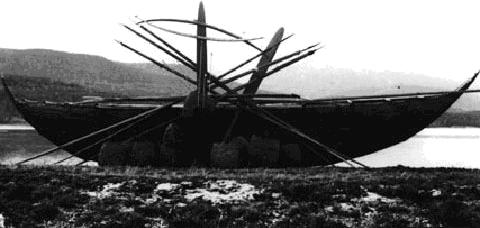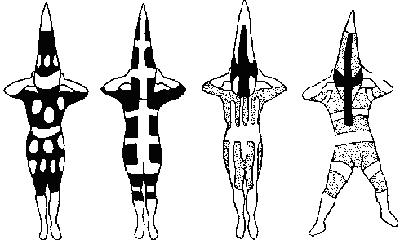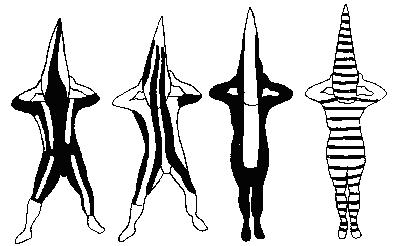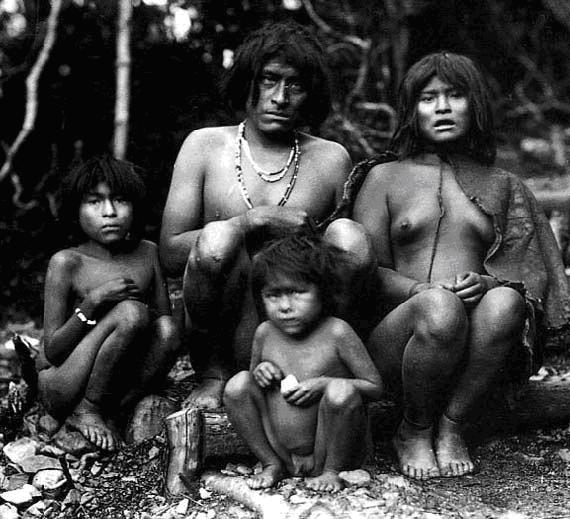THE YAGHAN
(Bu yazı içinde Şaman bahsi geçmektedir. Kırmızı ile işaretlidir)

Ethnonyms
Demography
Relationship to Ona
Subsistence Strategies3
Sexual Division of Labor
Social Organization
Rituals
Clothing
Bibliography
Back to South American Foragers
Ethnonyms: Yámana, Yagán, Tequenica, Háusi, Kúta

Demography
At the end of the 18th century the Yahgan population varied between 2,500 to 3,000 people. Between
the 1880s and the 1930s epidemics of respiratory diseases, measles, typhoid, whooping cough, and smallpox brought into contact by the Europeans, wrought devastation upon the population. According to Cooper the population dwindled to about 1,000 in 1884; to 400 in 1886; 200 in 1899; 130 in 1902; 100 in 1913; and to 40 in 1933 (Cooper, 1946, 83). This picture is of the last known surviving Yahgan man. His name was Felipe and he past in 1976.
Relationship to Ona
The Yahgan and the Ona are both known as the Indians of Tierra del Fuego or collectively as Fuegians.
What is interesting is that while both of these groups shared an island together they do not speak the same language or even languages with a common background. The Yahgan spoke what is known as a language isolate or a language completely underived from another language . The Ona and Yahgan also differ greatly in height and body stature. The Ona are on average almost 17 cm taller than the Yaghan.
Subsistence Strategies

The Yahgan were strictly hunter-gatherers, they grew no plants and had no domesticated animals except the dog which they did not eat. The majority of the Yahgan diet is made up of meat either collected or hunted. The only vegetation eaten were wild celery, wild parsnips, two varieties of cress, a few berries, a kind of tree fungus, and young shoots of tussock. The lion’s share of the meat came from seal hunting/fishing and was aided by sea urchin, crabs, mussels, conches, penguins, geese, otters and limpets. The occasional beached whale also provided for the Yahgan and while active whale hunting was not unheard of it was rare and only sick and dying whales were considered worth hunting
Sexual Division of Labor
Among the Yahgan the different labor chores were divided based upon sex. The men did the hunting, fishing, tool and weapon making, and heavy construction of huts, whilst the women do the typical household chores of child rearing, cooking, cleaning, basket weaving, sewing, and also a not so common chore of having to dive into the ocean for shellfish. The men did the hunting, fishing, tool and weapon making, and heavy construction of huts, whilst the women do the typical household chores of child rearing, cooking, cleaning, basket weaving, sewing, and also a not so common chore of having to dive into the ocean for shellfish.
Social Organization
The Yahgan were a male centered society, in which the father was the leader for his family. This was as high as people went in terms of politics. There were no chiefs or tribal leaders to speak of although much respect was given to opinions of the shaman and of the elders. The lack of overall leadership is best explained by a lack of need for it, the Yahgan never did anything together and consequently did not need a leader. While traveling by canoe, two or more families often traveled together in order to more efficiently pack the skin housetops for the canoes and to have a much needed second canoe in order to erect the roof and skin housetops.
Social Organization
The Yahgan were a male centered society, in which the father was the leader for his family. This was as high as people went in terms of politics. There were no chiefs or tribal leaders to speak of although much respect was given to opinions of the shaman and of the elders. The lack of overall leadership is best explained by a lack of need for it, the Yahgan never did anything together and consequently did not need a leader. While traveling by canoe, two or more families often traveled together in order to more efficiently pack the skin housetops for the canoes and to have a much needed second canoe in order to erect he roof and skin housetops.
Rituals
The Yahgan were firm believers in rituals. First there was a training ritual for boys and girls, the Great Hut Rite. It was like a societal training boot camp. The boys and girls were taught how to do all the things that were going to be expected from them in adulthood; the boys how to hunt and fish, the girls how to sew and cook etc. Those that did not pass had to take it again the next time there was an abundance of food and the ritual would be honored again. The next ritual is called the Men’s House Rite and is only for boys who have twice passed the first ritual and marks the final stage in achieving full adult status in the community.


Examples of standard Yahgan body painting used in rituals
Clothing
One of the most astonishing things about the Yahgan is that despite living in an almost arctic region of the world they almost never wore clothes. They relied on a coating of fish and seal oil as a body covering. Even in summer this is an accomplishment given that the mean temperature is around 50° F, but to think of walking around in near freezing temperatures in winter covered only with fish oil is truly remarkable. When the Yahgan did wear clothing it was only a simple article, like a pubic covering or loincloth which was worn by the females, or seal skin capes which were worn by both men and women. The only other article sometimes adopted by the Yahgan, were seal skin moccasins.

Ex. of a Yahgan woman wearing a cape
Bibliography
Cooper, John M.
1946. Handbook of South American Indians, edited by Julian H. Stewart, volume 1,The marginal tribes.95-97
Dowling, John H
1968. Individual Ownership and the Sharing of Game in Hunter Societies. American Anthropologist, New Series, Vol. 70, No. 3. pp. 502-507.
Gusinde, Martin
1937. The Yahgan: the life and thought of the water nomads of Cape Horn. Die Feuerland-Indianer [The Fuegian Indians]—Vol. II: 866-869
Hill, Kim and Kaplan, Hillard
1985. Food Sharing Among Ache Foragers: Tests of Explanatory Hypothesis. pp 223- 246
Lothrop, Samuel Kirkland
1928. The Indians of Tierra del Fuego. New York: Museum of the American Indian, Heye Foundation,. 1-47, 116-244 p